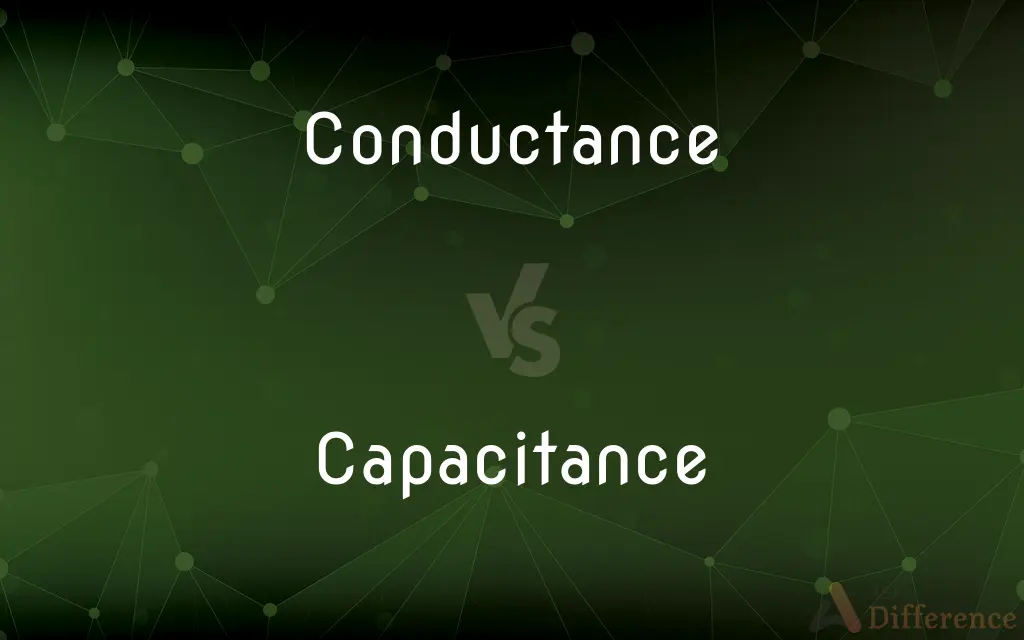Conductance vs. Capacitance — What's the Difference?
By Maham Liaqat & Fiza Rafique — Updated on April 30, 2024
Conductance measures how easily electricity flows through a material, expressed in siemens; capacitance measures the ability of a system to store an electric charge, expressed in farads.

Difference Between Conductance and Capacitance
Table of Contents
ADVERTISEMENT
Key Differences
Conductance is a measure of the ease with which an electrical circuit or component allows the flow of electric current, typically measured in siemens (S). This concept is particularly relevant in electrical and electronic engineering, where higher conductance indicates lower resistance. Capacitance, on the other hand, quantifies the ability of a physical system to store an electric charge, measured in farads (F). It plays a critical role in the design of circuits involving AC (alternating current) and signals.
Capacitors, devices that exhibit capacitance, are used to store electrical energy temporarily in an electric field created between pairs of conductors. The amount of capacitance is dependent on the surface area of the conductors and the distance between them, as well as the type of dielectric material used. Conversely, conductance is influenced by factors such as the material's intrinsic properties and the physical dimensions of the conductor, including its length and cross-sectional area.
The principle of conductance is integral to the operation of resistors and conductive materials, which are designed to offer specific resistance to current flow. Higher conductance in such components translates to a lower resistance value. Whereas, capacitors are employed in various applications like tuning circuits, power supply filters, and sensor interfaces, where their ability to store and release charge rapidly is invaluable.
In practical applications, systems with high capacitance might be used in energy storage solutions or dynamic electronic filtering. Conductance values are crucial in systems requiring efficient current transfer, such as in power distribution networks. These characteristics ensure that each property is optimized for specific functionalities within electronic circuits.
While conductance is a straightforward measure of how easily current flows through a material, capacitance involves more complex interactions between electric fields and dielectric constants of materials. These differences underscore the distinct ways in which electrical behaviors are utilized in technology and engineering solutions.
ADVERTISEMENT
Comparison Chart
Definition
Ability to conduct electricity
Ability to store electric charge
Units
Siemens (S)
Farads (F)
Influencing Factors
Material type, area, and thickness
Area of plates, distance between them, dielectric
Typical Uses
Electrical circuits, resistors
Capacitors, energy storage, tuning circuits
Physical Principle
Governed by resistance
Based on electric field storage
Compare with Definitions
Conductance
Measure of how easily electricity flows through a material.
A silver wire has high conductance due to its low resistivity.
Capacitance
Dependent on the geometry and dielectric material.
Increasing the plate area of a capacitor increases its capacitance.
Conductance
Inversely related to resistance.
As the resistance decreases, the conductance increases.
Capacitance
Integral to the design of electronic filters and oscillators.
Capacitance is critical in the tuning of radio frequency circuits.
Conductance
Affects the electrical properties of circuits.
Changing the conductance in a circuit alters the current flow.
Capacitance
Influences the timing in circuits.
A timer circuit’s delay is set by the capacitance value.
Conductance
Quantified in siemens.
The conductance of the circuit could be measured in siemens.
Capacitance
Measured in farads.
This capacitor has a capacitance of 1 microfarad.
Conductance
Important in determining the efficiency of electrical transmission.
Higher conductance materials are preferred for power cables.
Capacitance
Property of a system that enables it to store an electric charge.
The capacitance of the capacitor determines how much charge it can hold.
Conductance
Symbol G A measure of a material's ability to conduct electric charge; the reciprocal of the resistance.
Capacitance
Capacitance is the ratio of the amount of electric charge stored on a conductor to a difference in electric potential. There are two closely related notions of capacitance: self capacitance and mutual capacitance.
Conductance
Thermal conductance.
Capacitance
The ratio of charge to potential on an electrically charged, isolated conductor.
Conductance
(physics) A measure of the ability of a body to conduct electricity; the reciprocal of its resistance.
Capacitance
The ratio of the electric charge transferred from one to the other of a pair of conductors to the resulting potential difference between them.
Conductance
Conducting power; - the reciprocal of resistance. A suggested unit is the mho, the reciprocal of the ohm.
Conductance is an attribute of any specified conductor, and refers to its shape, length, and other factors. Conductivity is an attribute of any specified material without direct reference to its shape or other factors.
Capacitance
The property of a circuit element that permits it to store charge.
Conductance
A material's capacity to conduct electricity; measured as the reciprocal of electrical resistance
Capacitance
The part of the circuit exhibiting capacitance.
Capacitance
The property of an electric circuit or its element that permits it to store charge, defined as the ratio of stored charge to potential over that element or circuit (Q/V); SI unit: farad (F).
Capacitance
An element of an electrical circuit exhibiting capacitance.
Capacitance
An electrical phenomenon whereby an electric charge is stored.
Capacitance
A measure of the ability of a capacitor to store electrical charge; the ratio of the charge on one plate of a capacitor to the potential difference between the plates.
Capacitance
An electrical phenomenon whereby an electric charge is stored
Capacitance
An electrical device characterized by its capacity to store an electric charge
Common Curiosities
How is capacitance measured?
Capacitance is measured in farads (F).
Can the units of conductance be converted into resistance?
Yes, conductance in siemens can be converted to resistance in ohms as they are inverses of each other.
Why is capacitance important in electronic circuits?
Capacitance is essential for storing electric charge and controlling the dynamics of AC signals and timing in circuits.
How do changes in conductance affect an electrical circuit?
Changes in conductance can increase or decrease the current flow, impacting the circuit's performance.
What is conductance?
Conductance is the measure of a material's ability to allow the flow of electric current.
What role does the dielectric constant play in capacitance?
The dielectric constant of a material affects how much electric charge a capacitor can store for a given size.
How does the thickness of a conductor affect its conductance?
Increasing the thickness of a conductor generally increases its conductance by providing a larger area for current flow.
What factors affect the capacitance of a capacitor?
The capacitance is affected by the size of the conductive plates, the distance between them, and the type of dielectric material used.
What is a typical application of high conductance materials?
High conductance materials are typically used in power transmission lines to reduce energy losses.
Are there any devices specifically designed to measure capacitance?
Yes, devices such as LCR meters are designed to measure capacitance, inductance, and resistance.
What is the difference between conductance and conductivity?
Conductance is a measure of how easily electricity flows through a specific component, while conductivity is a material property indicating how well a material conducts electricity.
What happens to capacitance if the distance between plates increases?
Increasing the distance between the plates of a capacitor decreases its capacitance.
In what scenarios is low conductance preferred?
Low conductance is preferred in resistors used to limit current flow in circuits.
How does temperature affect capacitance?
Temperature can change the dielectric constant of a capacitor, thereby affecting its capacitance.
What are some practical applications of capacitors in modern technology?
Capacitors are widely used in electronic devices for smoothing voltage fluctuations, power conditioning, and signal processing.
Share Your Discovery

Previous Comparison
Agate vs. Monsoon
Next Comparison
Policy vs. ProgramAuthor Spotlight
Written by
Maham LiaqatCo-written by
Fiza RafiqueFiza Rafique is a skilled content writer at AskDifference.com, where she meticulously refines and enhances written pieces. Drawing from her vast editorial expertise, Fiza ensures clarity, accuracy, and precision in every article. Passionate about language, she continually seeks to elevate the quality of content for readers worldwide.
















































